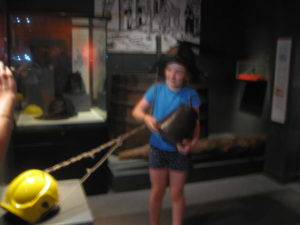The last person to be interested in anything is an exhausted child. The last place you want to take one is a museum on a steamy day. And what happens? Prehistory grabs them: huge bones, dioramas, skulls and they’re hooked.
Our only worry was whether this child would emerge in time to see what else this treasure house provides. No need: she did and with due allowance found a wealth of interest.
Each time we’ve been to this unprepossessing area of the ruins that Hitler, never mind Cromwell, knocked about a bit, I’ve wondered whether the rebuilding was in some ironic way a product of Albert Speer, Hitler’s architect. I know they wanted to evoke the medieval barbican and felt sympathetic towards the remains of its Roman predecessor but brute-modernism does nobody any favours. All credit then that the museum takes its visitors away from all that – until of course they reach the area recording the Blitz.
For a dwindling number, silver and a good deal more than silver-aged, the Blitz display is what brings them back. A very few remember what it was like as adults; rather more, like me, were children at the time. It evokes a depth of memory: of people no more among us, events that may have terrified, certainly stirred with wonder, and comradeship of different ages. You hear them uninhibitedly reviewing their experiences.
That’s the other end of the time scale, however. We were there with a grandchild and her mother, so it was the “Horrible Histories” experience that mattered. And the museum has those aplenty. Roman interiors that could be Conran-designed, with food and drink easily identified; the floor tile that a cat walked over before the clay had dried; the child’s coffin and the picture of its funeral; the “Meet the Ancestors” woman reconstructed next to her coffin – these are irresistible, and outside a nearby window, the Roman tower itself.
Moving on, there’s a chance to sit or lie inside an Anglo-Saxon house, to try on a Tudor doublet or headdress, walk through an arch of the period or learn about the Black Death.
Perhaps the Civil War needs a curricular interest for children though it fascinates many of us as adults, but the fire of London is something else. Surprisingly the fire re-enactment itself provided no attraction for our grandchild: tiredness from the previous week’s outdoor activities was setting in. She did find the seventeenth century fire helmet and its comparison with the modern version something to try on though.
A few minutes in an eighteenth century pleasure garden with on-screen dramatic episodes were both of interest and restful. The fantastic costumes were a great draw: nothing to try on here, though – perhaps it would have created too much of a bottleneck. The Victorian street was also fascinating; so was “The Great Stink” and its interactive display of the causes of cholera and Bazalgete’s brilliant solution to sewage disposal.
Twentieth century London seems very definitely for adults, so we were carried swiftly through then brought back to the eighteenth century with the immensity of the Lord Mayor’s coach.
Good refreshments opportunities before and after make for a complete experience, though the museum has thoughfully provided a room where not only school parties but also families can eat their own food. We ex-Londoners can envy those who’ve stayed behind their easy access to the Museum of London yet make the most of it whenever we return for a day.










